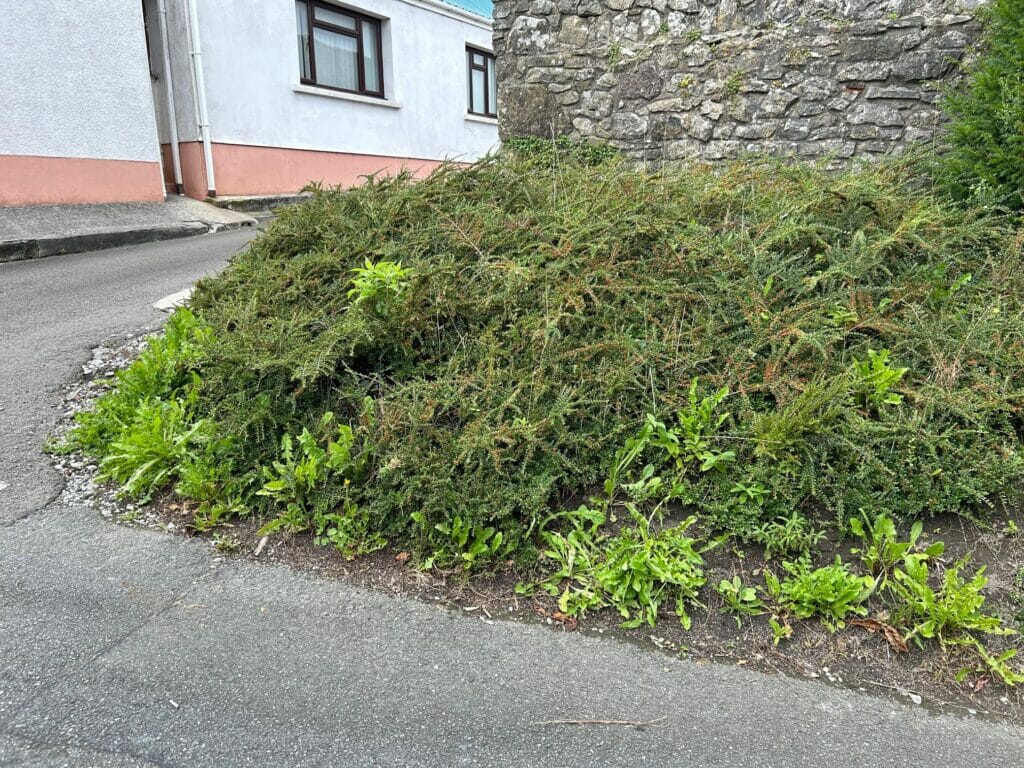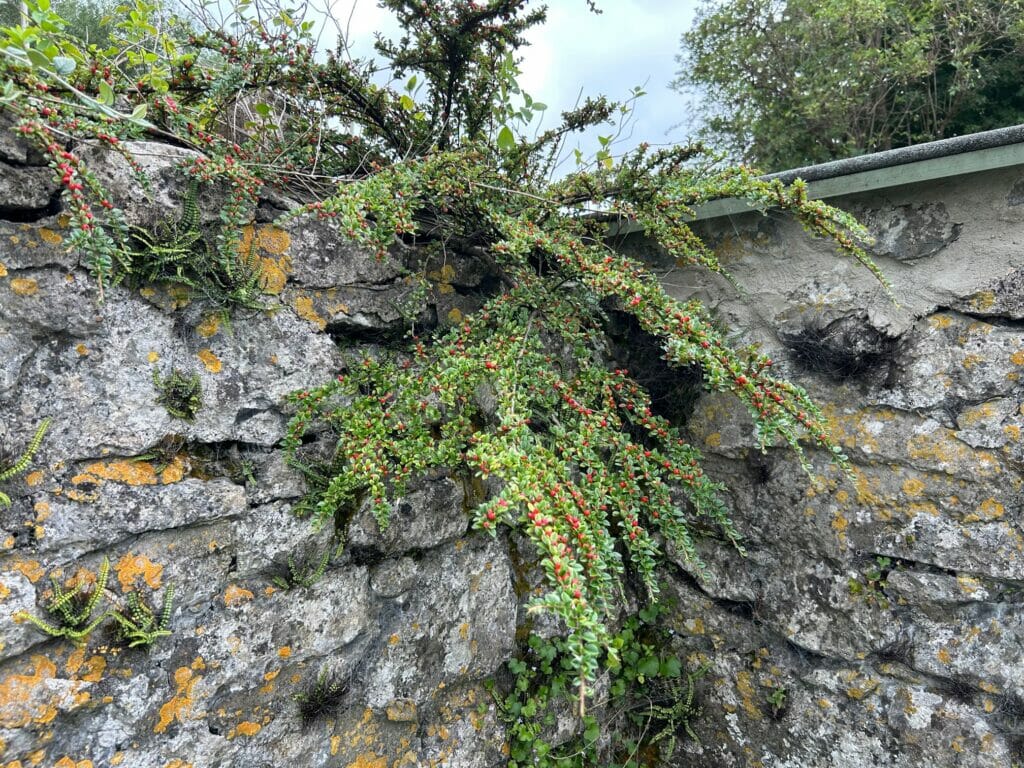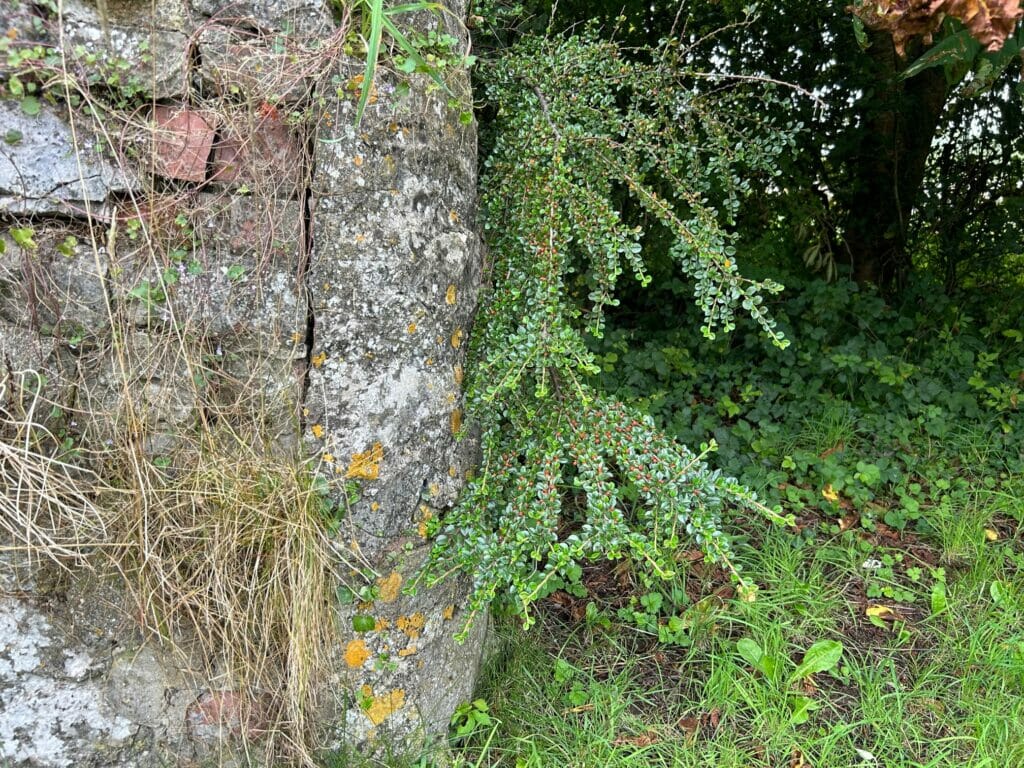Cotoneaster is a UK non-native species that thrives in a variety of soil conditions. The plant’s ability to cope with poor limestone, chalk and sandy soils has contributed to its impact on native habitats. An ecological concern around coastlines, limestone cliffs and grasslands, cotoneaster has also become a headache for property dwellers. Cotoneaster removal from walls and between paving slabs has become common place. Spreading cotoneaster thickets are often seen in flowers beds with other smaller shrubs establishing themselves near by. Many species grow into dense thickets, and the cotoneaster root system is woody, deep and tough.
Often it becomes necessary to call upon professionals to remove larger areas of established cotoneaster and cotoneaster roots. As cotoneaster spreads by seed, there is a need to ensure the entire plant is removed, but also any soil that might contain the seeds. It is important to note that some species of cotoneaster in the UK are listed as invasive in Schedule 9 plants on the Wildlife & Countryside Act. This gives need to dispose of all contaminated soil to a licensed landfill as controlled waste, to prevent the plants spread.
What is cotoneaster?
Cotoneaster is a genus of plants in the Rosaceae family. There are hundreds of species, many of which were introduced to the UK as ornamentals. Cotoneasters have attractive foliage with small, glossy leaves that are dark green. They exhibit a range of growth habits: some are deciduous, some evergreen and they vary in size from large shrubs to small trees.
Cotoneaster flowers are typically white or pink and are followed by small, usually red berries that stay on the plant for the majority of the winter months, unless eaten by birds. Cotoneaster is a versatile plant family with wide use in landscaping as hedging, ground cover, in mixed borders or screening for walls and fences. The flowers are very attractive to pollinators, such as bees and butterflies and the berries it produces, are food for birds.

Spreading cotoneaster thicket on a roadside verge © PBA Solutions

Cotoneaster root system embedded in a wall © PBA Solutions
Cotoneaster UK Issues
Considerations for removing cotoneaster invasive species from a UK garden:
- 5 species of cotoneaster are considered invasive non-native species in the UK.
- Cotoneaster quickly out-competes native plants as it has no natural pests or diseases that have co-evolved with it in the UK to control its spread.
- Allowing cotoneaster to spread into the wild is considered an offence against the Wildlife & Countryside Act. Fines can be given to those not taking appropriate precautions to prevent the spread of cotoneaster into wildlife habitats.
- Cotoneaster berries are easily dispersed by birds, contributing to widespread distribution of the plant and impacting vulnerable habitats.
- Cotoneaster spp. contain cyanogenic glycosides which are toxic to humans and pets.
- The rapid spread of the plant can lead to cotoneaster becoming dominant in the garden. It is capable of quickly creating a dense thicket of shrubby growth that shades out other plants. Cotoneaster also spreads beyond boundaries.
Is cotoneaster illegal in the UK?
There are over 100 species of cotoneaster cultivated in the UK; but are all species of cotoneaster invasive? Whilst many of the species spread rapidly, only five species are actually classified as ‘invasive species’. It is not illegal to plant cotoneaster in your garden. However, it is an offence to allow any of the five invasive species to spread. You also do not need to notify anyone of the presence of invasive cotoneaster on your land, when selling your property, unlike Japanese Knotweed.
Inclusion in Schedule 9, precludes anyone from spreading the invasive cotoneaster species into the wild, or onto neighbouring land. Although invasive varieties are readily sold in garden centres and nurseries, it is strongly advised not to purchase them. This is important because incorrect disposal of plant cuttings, or removed plants, could lead to the plants spreading into the wild. Particular caution should be taken when disposing of listed Schedule 9 cotoneaster soils, roots and seeds.
Cotoneaster invasive species as listed in Schedule 9
There are five UK invasive species of cotoneaster listed in Schedule 9 of the Wildlife & Countryside Act; more than any other invasive plant on the list. They are:
| Common name |
| Cotoneaster |
| Cotoneaster, Entire-leaved |
| Cotoneaster, Himalayan |
| Cotoneaster, Hollyberry |
| Cotoneaster, Small-leaved |
Cotoneaster Roots
Cotoneaster root systems are extensive and will help the plant regrow if it is cut back hard and aerial parts are removed completely. Cotoneaster roots are woody and tough, and on larger established plants, help might be needed with manual cotoneaster removal. Although species such as Cotoneaster horizontalis are known to be shallow rooting, the sturdy, widespread roots are hard to take out of the ground by hand. Cotoneaster root systems should be removed completely to ensure that regrowth of the plant is prevented.
Are cotoneaster roots deep?
Less mature cotoneaster plants have shallow but wide spreading root systems. Some have branches that grow low to the ground that can also form roots where they touch the soil, in a process called ‘layering’. Long established cotoneaster plants will have deeper, more extensive root systems.
How to get rid of cotoneaster
You may require professional assistance removing cotoneaster that has become a problem in your garden. Invasive cotoneasters (those listed on Schedule 9), should be dealt with by a team with the right tools and skills. The process will require the removal of all the above ground material, excavation of the cotoneaster root system and soil with dispersed seeds. Disposal of contaminated soil and plant material should be done within legislative guidelines at a licensed landfill.
The best option for completely removing cotoneaster plants is digging them out. Small cotoneaster seedlings can be pulled up with the help of a garden fork to loosen the soil around the roots.
Large established cotoneasters with extensive root systems may need a professional to assist. Plant material needs to be burned or chipped on site, or removed to a licensed landfill as controlled waste.

Cotoneaster horizontalis (wall cotoneaster) growing out of a wall © PBA Solutions
Herbicide treatments can be used professionally when mechanically dealing with a cotoneaster problem isn’t possible. For example, when rooted in a wall, patio or in a small space with poor access. The challenge with this approach is repeated treatments required. It may take several seasons before the plant is fully eradicated. However, in some circumstances this may prove the most practical option.
At PBA Solutions, we deal with a wide range of invasive plant species. We are always happy to offer identification assistance and offer advice on the best solutions. If you are concerned about spreading cotoneaster or another invasive plant species, call 0203 174 2187 or 01202 816134 to talk to one of our consultants today.
Lead image © PBA Solutions

